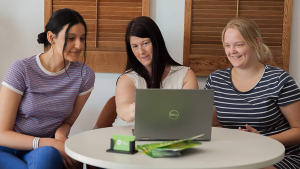The NDIS supports people with a disability to live independently in many different ways. There are many options available depending on your individual situation and NDIS funding. In this article, we explore Individualised Living Options (ILO) and if it is the best option to support your independent living goals.
What is Individualised Living Options support?
ILO supports help you to live alone or independently in someone else’s house but don’t cover the house itself or the cost to live in it. It is distinct from Specialist Disability Accommodation (SDA) funding which focuses on the housing. It is possible to have an ILO package while living in SDA.
If one of your goals is to live as independently as possible, your ILO funds can be ILO can also be tailored to teach you these skills.
There are two stages to the funding, which works as part of your NDIS plan.
The first stage funds the support to determine how and where you want to live, what your strengths are, who you may wish to live with, what you need to do to build on your weaknesses and what supports you may need to achieve this. When you have completed the first stage, you can then work with your support team to develop a proposal to be submitted to the NDIA. This will detail what the NDIA needs to know about how you wish to live. If approved, the second stage is to roll out your services and monitor and refine over time.
Generally, ILO is for people with disability over the age of 18 who need more than six hours of help at home every day (including for problem solving or decision making), are ready to explore their home and living needs and willing to put time and effort into designing their future home.
The first part of ILO funding, to explore living support options, can also be used by people with disability who are still 17 and want to start planning to move out of home as one of their NDIS goals.
What supports can ILO include?
A wide range of supports are available as the funding is designed to match an individual’s needs so they can live the way they choose. These may include:
- Helping you decide where to live and what you need to make this happen
- Support workers to assist with in-home support needs such as personal care, shopping, cleaning, cooking or paying bills
- Help to set up and manage your home
- Capacity building to help you become more independent
- Connecting with other people
- Help with daily decisions
- Support to manage emotions or behaviour
- Training for people who support you
- Unpaid volunteers who can help regularly. (Source: NDIS)
Formal versus informal supports
Supports can come from a range of different sources and can be formal or informal.
Formal supports are provided by businesses, organisations or providers like those that provide in home support or mentors for recreational activities.
Informal supports are those given by friends and family and are often as important to you being able to live independently.
Both kinds of support are considered in ILO funding, although your informal supports from family and friends are not paid supports.
What ILO living arrangements are available and what supports are covered?
It’s important to note if you have ILO, the NDIS won’t help you to find somewhere to live. In most cases, you need to arrange this yourself.
ILO will support many types of living arrangements, including if you:
- Share a home with family, friends or other people with an NDIS plan
- Rent a house from a landlord or real estate agent
- Live in public or community housing
- Own or are paying off your own home
- Live in a host arrangement in the home of a host you don’t know.
ILOs are not group homes, placements or shared accommodation services and they don’t cover 1:1 programs of rostered care. These are more likely to be provided via Supported Independent Living funding.
In home supports such as help with personal care, cooking, cleaning, shopping, laundry, finances or emotional support can be included, but there are also several different types of households in which people with an ILO package can live.
A host living arrangement for example is available for adults on the NDIS who choose to live with a person or family they are not related to (a host) who gives them disability support, emotional support and help around the house. The host is paid through your NDIS plan and there is an arrangement about what kinds of support they will provide. In exchange for their support, the host will receive financial help with paying rent and utility bills.
Another option is for housemates or co-residents to live in your home and under an agreement to provide support and companionship in return for a reduced rent or payment.
Supports can also include another person or a team of people, known as mentors, who you choose to spend time with to develop social skills and participate in recreational or community activities. Mentors are usually paid a salary as they can spend long periods of time providing you with direct and indirect support.
Additionally, friends and family can be part of ILO, for example by providing emotional support or helping with social connection.
What are the benefits of an ILO?
- Greater flexibility and fewer restrictions
- Choose where you live and who you live with
- Live alone or with family or friends
- Get NDIS support whether you rent, have a mortgage or own your property
- Access more stable and consistent supports
- Improved capacity building options.
These supports can be particularly helpful if you want to move out of your family home or group home. The package can be changed as your needs change and is more flexible than Supported Independent Living – which is funding most commonly used when living in shared housing.
ILO and SIL can’t be funded at the same time but they can both provide some similar supports, like personal care and support to develop life skills.
One of the benefits of ILO is its ability to take into account how you might like your family and friends to be part of your support and work with funded services so that all the different supports flow together. It is also a good option for people who do not want to be restricted to living in areas where group homes are located as you can use the package to live anywhere.
The flexibility of funding means ILO may be the best way to meet your needs and management of the funding is also flexible as you can self-manage, get help to run it from a plan manager, or it can be managed by a provider.
How to get ILO included in your NDIS plan
If one of your NDIS goals is linked to living support that you are not getting in other ways, you can fill out a Home and Living Supports Request Form to start the process of finding out if ILO is the best option for you.
The form is a way for you to provide information to the NDIA about what your situation is, your strengths, obstacles and ongoing needs.
Once you have supplied that information, the NDIA will look at funding the first stage or suggest another appropriate housing option to support you to build your independence and capacity. You will then complete the Services Proposal to request the second stage of funding for those supports.





